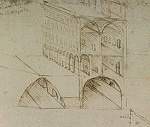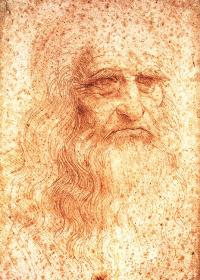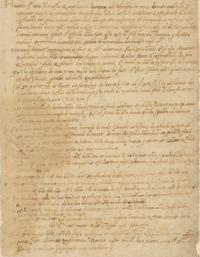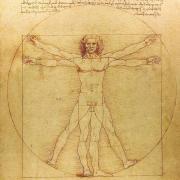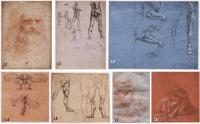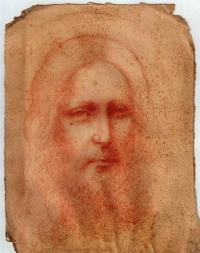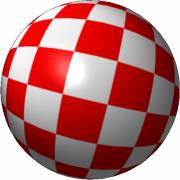Biography of Leonardo da Vinci
A Renaissance Man

1. Biographical data
Leonardo da Vinci was born on April 15, 1452 in the town of Vinci (although it could have been in the hamlet of Anchiano, about 2 km from Vinci) in the Republic of Tuscany (Italy), as the illegitimate son of Piero Fruosino da Antonio, a wealthy notary. Leonardo's father had been marriage to a 15-year-old girl from a peasant family named Caterina. Messer Piero, married up to four times. The last of his wife, Lucrezia Guglielmo Cortigiani, provides him with great affection, incorporating him into the rest of her family. Since until then Leonardo had lived with his paternal grandfather Antonio da Vinci, a well-off gentleman, who endowed him with a good amount of money to Leonardo's mother so that she could marry as she did with a peasant named Antonio di Piero Buti. Leonardo had 12 brothers from his father's marriages. He himself never married.
Leonardo died on May 2, 1519, at the age of 67 in the castle of Clos-Lucé (although some historians place his death in the neighboring Cloix), near Amboise (France).
At his father's house, already married to the aforementioned Lucrezia, he learned to read and write and acquired knowledge in arithmetic. His writing was always chaotic and difficult to read and interpret, since being left-handed he wrote from right to left and could only read it in a speculative way. This characteristic was preserved throughout his life, in his numerous writings although not always in the signature of his works in which the word Leonardo or Io can simply be read.
In full adolescence his family moved to Florence. In that city controlled by the Medici family, he was trained both artistically, as a man of enormously multifaceted knowledge, coming to be considered in the history of Art as the Renaissance Man par excellence, as he gained knowledge in chemistry, metallurgy, and was formed in leather, plaster, mechanical and carpentry work.
Very soon the young Leonardo became interested in nature and drawing. In this last discipline he excelled in such a way that his father, at that time a personal friend of the great artist Andrea Verrocchio, presented him with one of his drawings. The master was amazed at his skill and took him as a pupil-apprentice in his Florentine workshop. In it the young Leonardo, apart from his duties as an apprentice (cleaning brushes and preparing and cleaning the workshop), learned working techniques in marble, bronze as well as painting, sculpture and drawing.
Much has been written about his alleged homosexuality, because he never married (his only known friend was Beatrice d'Este, of whom he made a beautiful portrait) and the fact that he lived with two young assistants, Gian Giacomo Caprotti da Oreno (Salai), which probably served as a model for his painting Saint John the Baptist and Francesco Melzi.
After his stay in Florence he also worked in Milan (sent by Giuliano dei Medici from Florence to strengthen political ties with the Sforza family), Rome, Venice, Mantua and finally France, invitated by the King Francisco I who accommodated him and his assistants Francesco Melzi (who inherited his brushes) and Salai in the castle of Clos-Lucé, neighboring the royal castle of Amboise.
2. Professional data
2 a. Florentine stage: Verrocchio's workshop
Verrocchio, seeing Leonardo's knowledge and skill as a painter acquired mainly after his years of apprenticeship in his workshop, allowed him to collaborate with him in one of the paintings he was finishing, the “ Baptism of Christ ” (fig. 1) (Uffici, Florence, Italy) where Leonardo was in charge of the painting of an angel (the one in the foreground on the left of the composition) and which was greatly admired by his master, as he is by far the best figure in the entire composition. He also commissioned and carried out the landscape background, something that always stands out in his later paintings.
Already at 20 years of age during his stay in Verrocchio's workshop, he was registered in the Red Book of the Painters Guild. In this period he was in contact with great painters of his time such as Boticelli, Ghirlandaio and Perugino. He also collaborated with the goldsmith Pollaiuolo who had his workshop near that of Verrocchio.
Leonardo, throughout his life, continued to cultivate the art of drawing with multiple themes such as human and animal anatomy, landscape and those concerning machines and other very diverse mechanical devices, and even portrait and self-portrait.
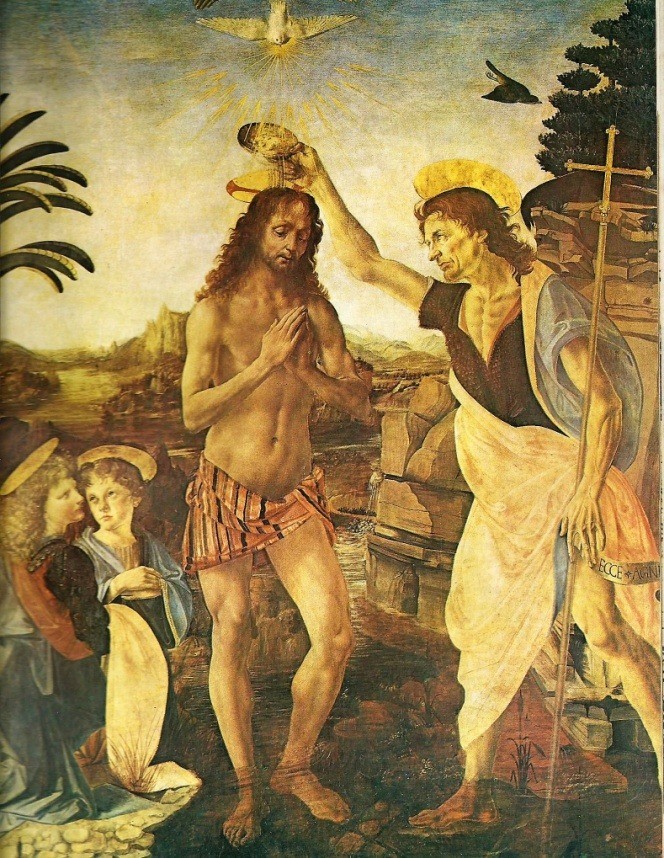
Apart from the aforementioned collaborative work (The Baptism of Christ), during his Florentine period he made drawings, one of which, the first known draw of Leonardo da Vinci, is the " Arno Valley Landscape " for some also known as " Landscape drawing for Santa Maria della Neve ” (fig. 2) dated 1473 (Uffici, Florence, Italy).
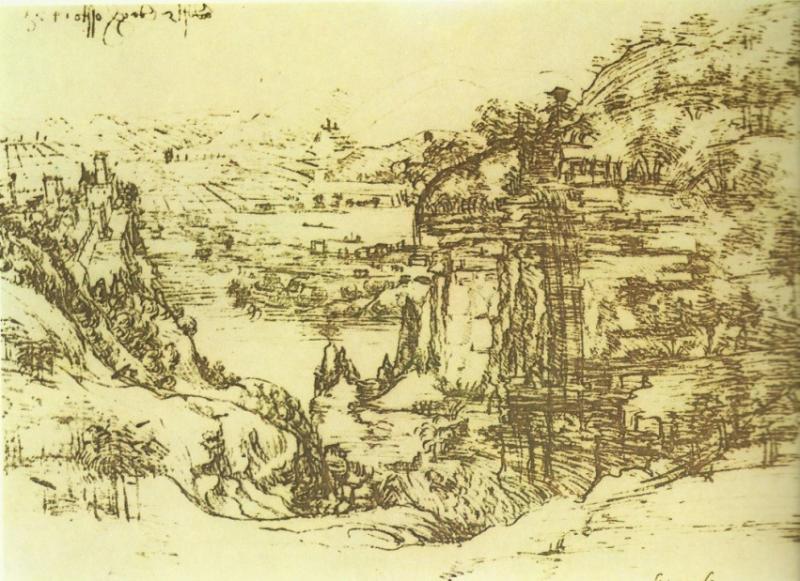
Leonardo's father encouraged him to open his own workshop in Florence (although he continued to collaborate with Verrocchio), from which came works such as " The Annunciation " dated 1472 (fig. 3) (Louvre, Paris),
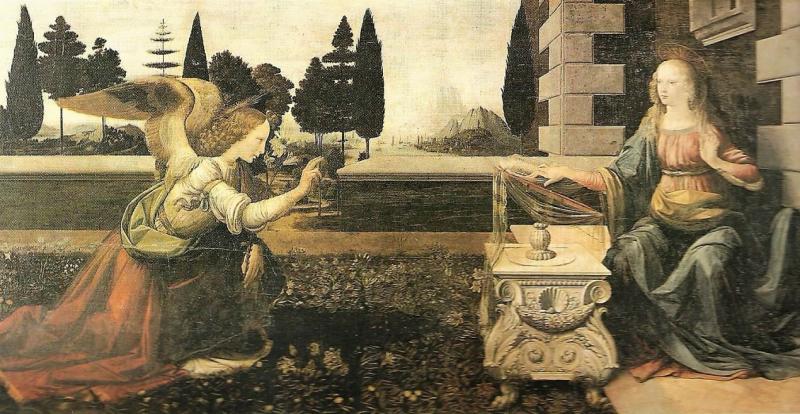
the " Madonna of the Carnation " (fig. 4) (Pinacoteca of Munich, Germany)
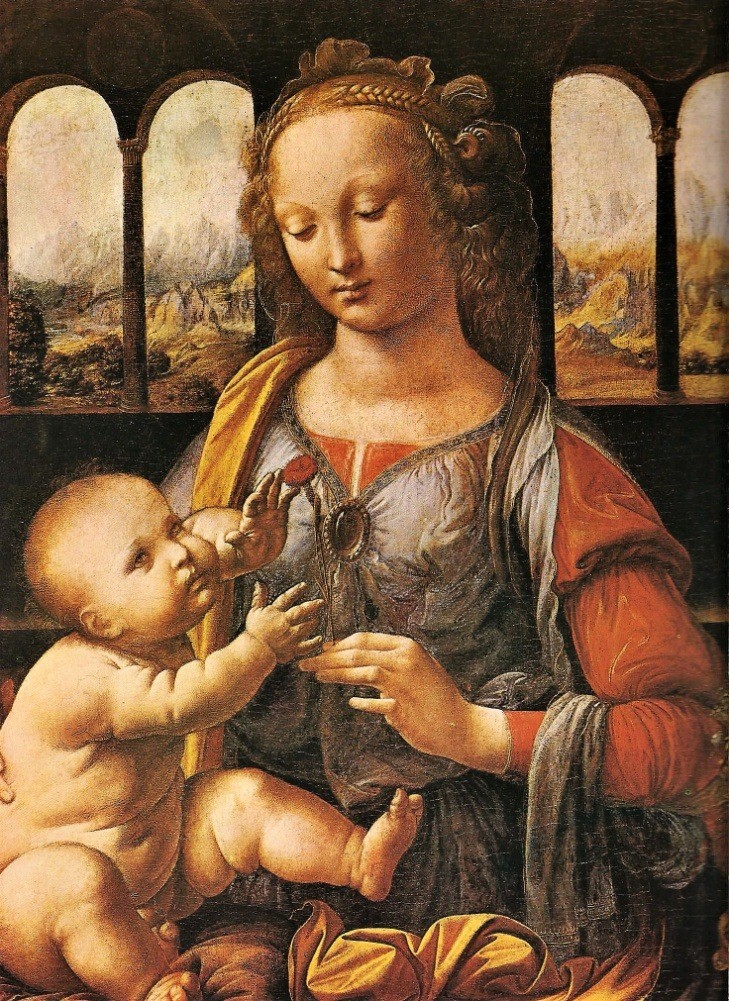
and the " Benois Madonna " or " Madonna and Child with Flowers " (fig. 5) from the Hermitage museum in Saint Petersburg, Russia.
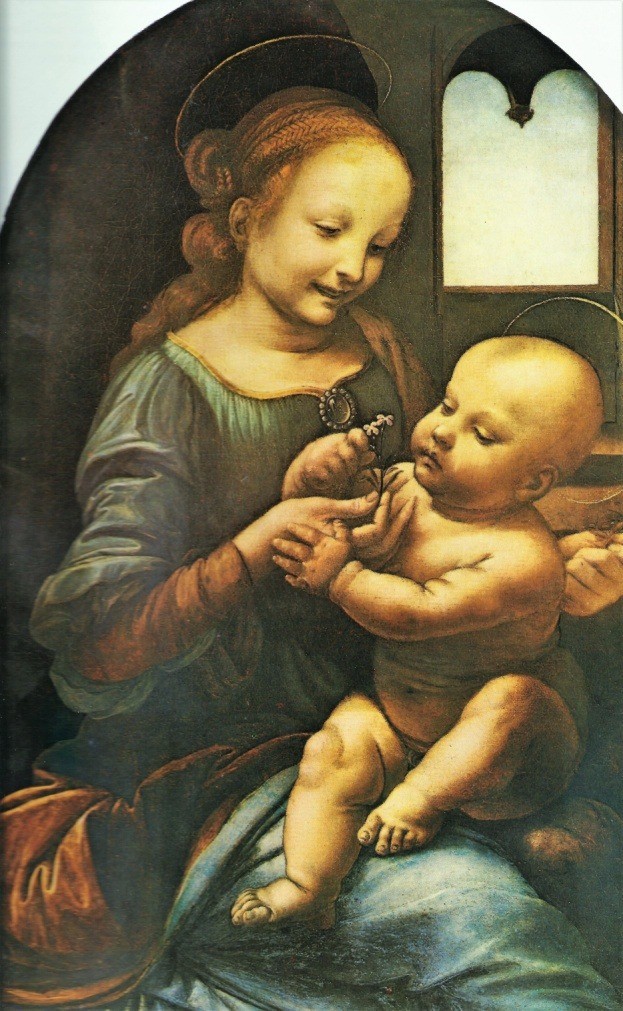
From this period is the beautiful painting of " Portrait of a Lady " (Ginevra de Benci) (fig. 6) located today in the National Gallery, Washington, in which, apart from the fineness of her features, her magnificent background of landscape with a juniper in light-dark behind the head of the lady ..
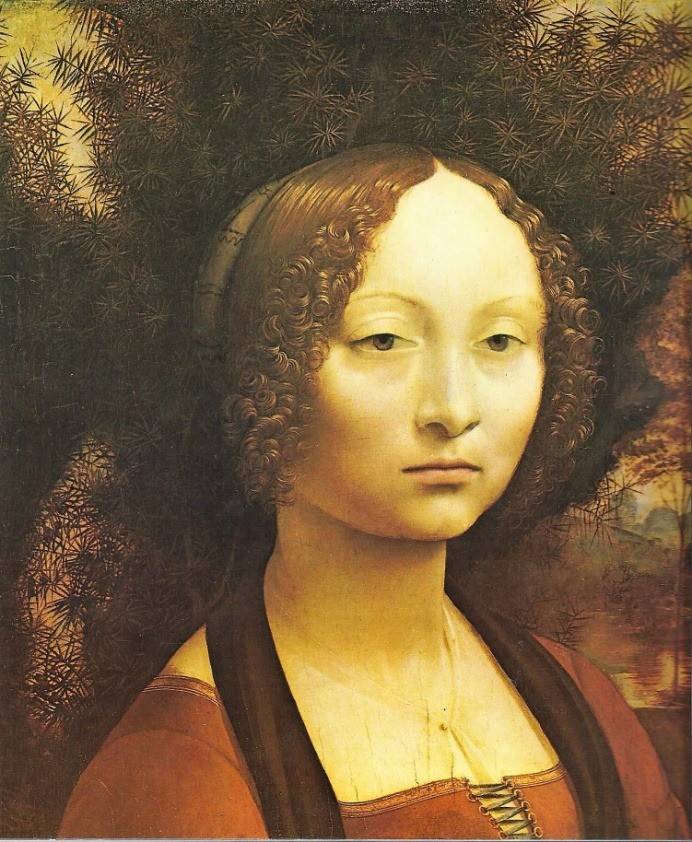
Another work that seems to date back to the early Florentine era was the " Saint Jerome " (fig. 7) whose expressionism corresponds to that described by Leonardo in his work " Treatise on Painting ". In this work, the study of the expressive possibilities of the saint's face constitutes a whole theory of physiognomy. This work is currently exhibited in the Vatican Pinacoteca.
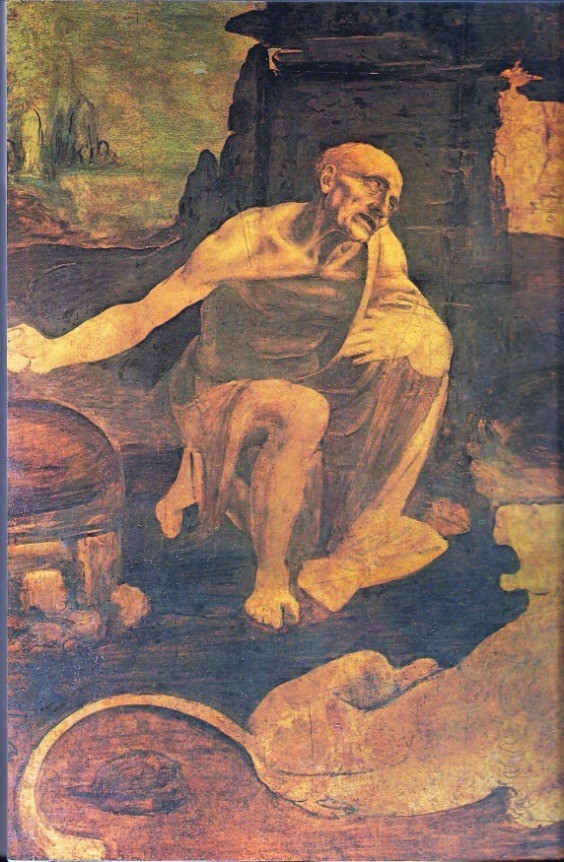
In the last years of his first stay in Florence, the Monastery of San Donato commissioned Leonardo " The Adoration of the Magi " (fig. 8), which is actually an unfinished work and which he left at the home of his friend Amerigo Benci when he moved to Milan. It has an extraordinary value for the study of Leonardo's pictorial techniques.
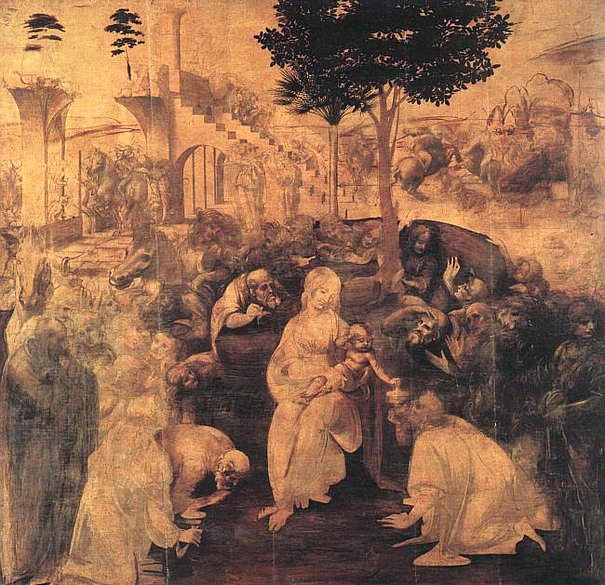
During his second stay in Florence, Leonardo created the most fascinating and famous female portrait of all universal painting: " La Gioconda " (fig. 9) transferred from its original destination in Florence to France by Francis I and there it remains in the museum of the Louvre.
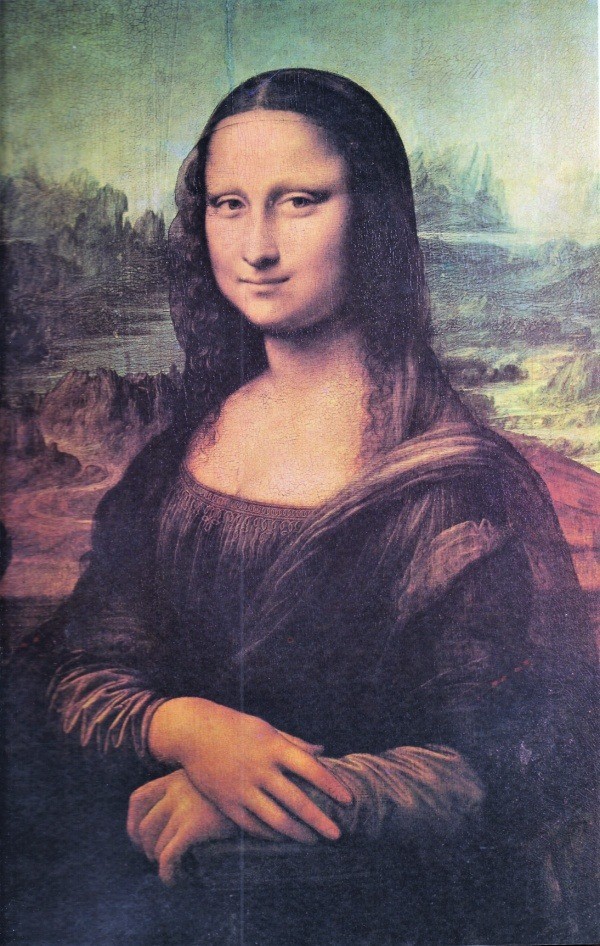
The work was commissioned by the wealthy Florentine merchant Bartolomeo del Giocondo who wanted a portrait of his wife Lisa Gherardini (married as Monna Lisa del Giocondo, the Mona Lisa, as she is universally known). In this work, Leonardo uses intensively the sfumato technique. The Gioconda is appreciated for its very modern framing, like a portrait that could be done today. More subtly Leonardo created optical effects such the location of the young woman's eyes and her famous smile. There are persons who say that one feels the impression of being constantly watched by the Mona Lisa, whatever the position from which one looks at him.
During this second Florentine stage Leonardo also painted the praised " The Virgin and Child with Saint Anne " (fig. 10) today at the National Gallery in London
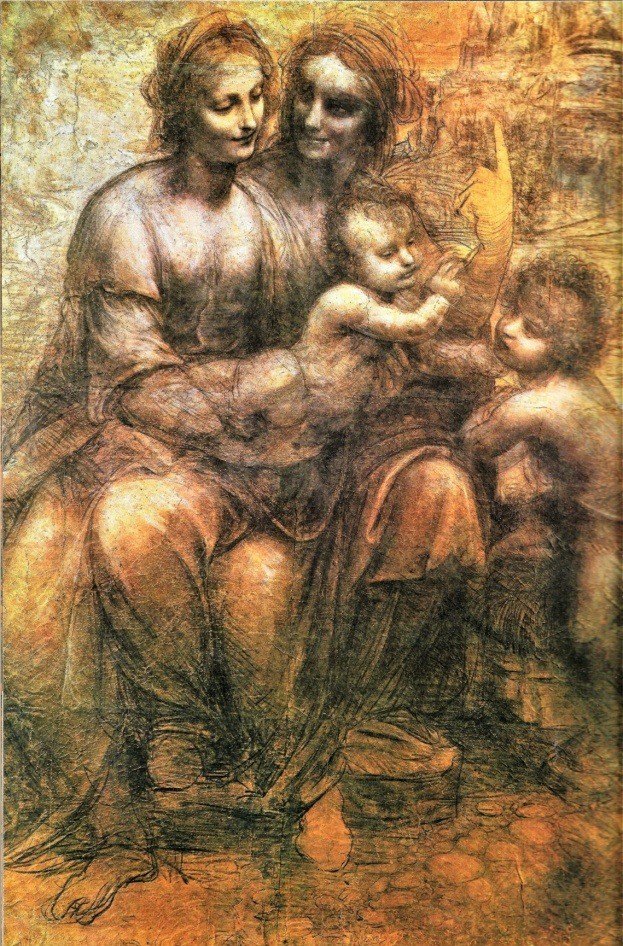
and " The Battle of Anghiari " sadly disappeared but which came to our days by a copy of Rubens (fig. 11).
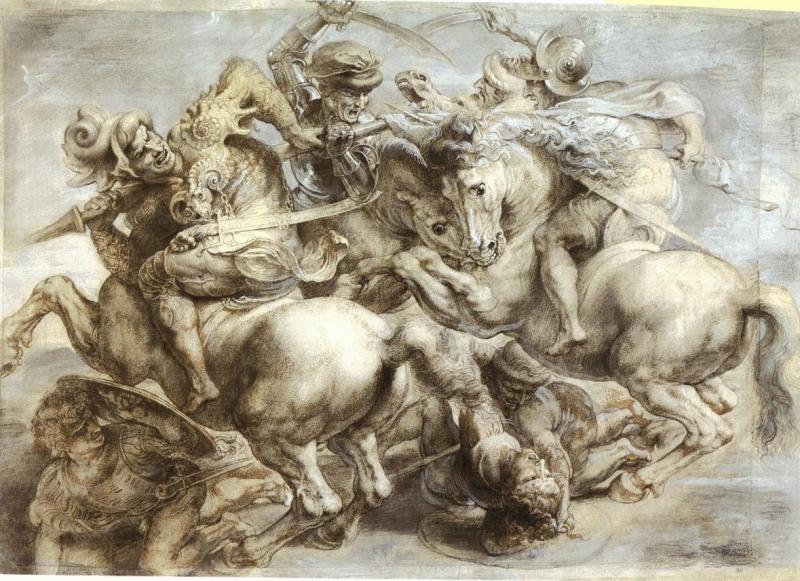
2b Milanese stage
Under the patronage of the powerful Duke Ludovico Sforza, a flourishing stage in the life of this artist began, from whom various works of great value were commissioned, thus considered in our days by historians and art experts.
The project that explained his trip, in addition to the strictly diplomatic-political one, was to be in charge of making a gigantic bronze statue of Ludovico Sforza. Project that was never finished because bronze was used to make cannons. Before arriving in Milan, Leonardo in a famous letter addressed to that Duke, had offered himself to him as an architect, painter, sculptor, engineer, gunner and hydraulic.
One of the famous paintings of this time by the painter, together with The Holy Supper, which will later be mentioned in detail, was " The Virgin of the Rocks " (1483-86) (fig. 12), in two versions.
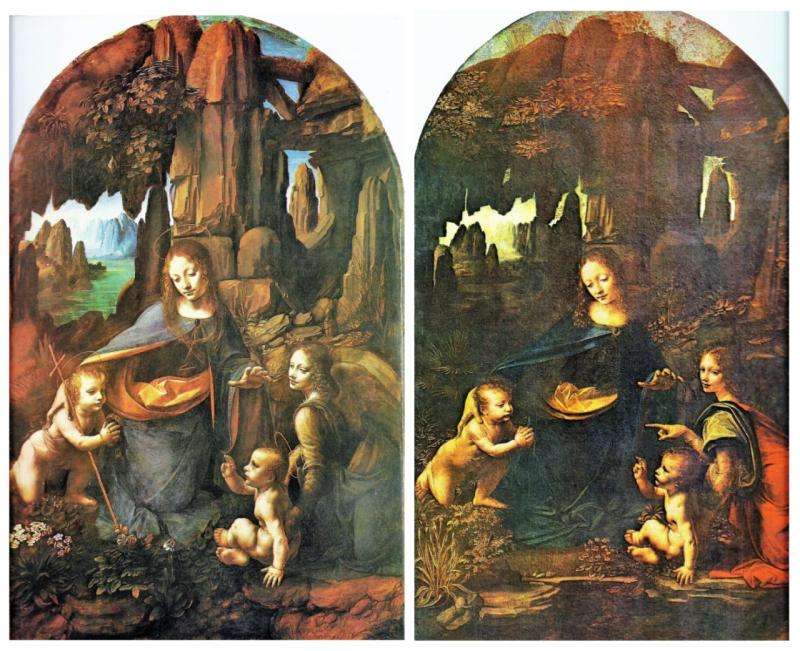
To be able to do both, Leonardo had to litigate in several lawsuits that ultimately failed in his favor and he was able to carry them out. This work was done for the Confraternity of the Immaculate Conception in its chapel of San Francisco el Grande in Milan. For some authors, the second version (in which Saint John carries a cross and the angel does not point a finger at him) was attributed to Ambroggio de Predis under the direct direction of Leonardo. In the version that is in the Louvre the perfect triangular structure of the disposition of the characters as well as the greater force of the "sfumato" and the sweetness of the faces of the angel, the Virgin and Jesus seem to belong without a doubt to the direct paternity by Leonardo. This first work after historical vicissitudes went to France, while the second stayed in Italy (Marco Rosci, History of Art J. Pijoan. Ed. Salvat). Later and in our days the first was in the Louvre while the other went to the National Gallery in London.
Between 1494 and 1498 he created one of his greatest works and not only because of its size but also because of the beauty of the study of the characters present in it: " The Last Supper " (fig. 13) for the convent Dominican of Santa Maria delle Grazie in Milan.
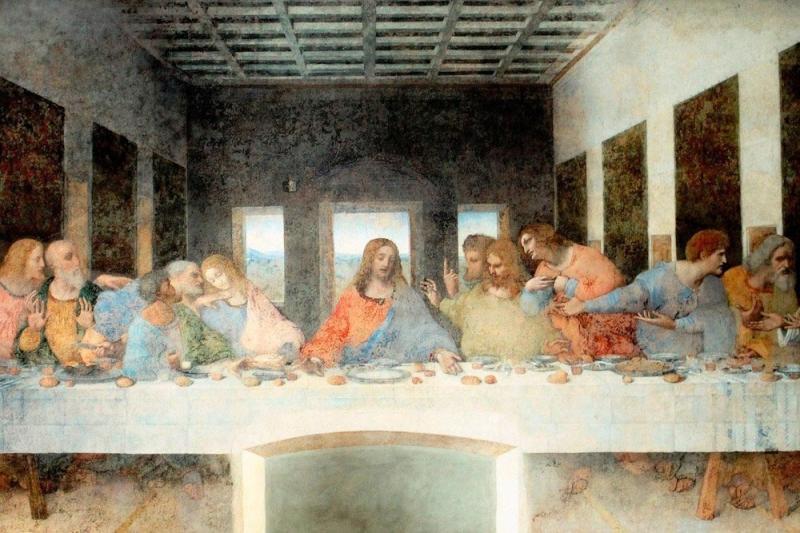
The work is painted in tempera, in two layers, with a complex technique (the second of plaster that allowed moisture to filter), which did not give good results in the long run, but although in our eyes of the 21st century it is a shadow of what It was, the beautiful and even enigmatic life-size figures together constitute in Vasari's words “a work of great majesty and beauty”.
Several portraits remain from this Milanese decade such as " Lady with an Ermine " in the Czartoryski Museum in Krakow, the " Portrait of a Lady with the pearl net " and the " Portrait of a Musician ", both in the Galleria Ambrosiana in Milan (Italy) and the " La Belle Ferronnière " (Louvre), (fig. 14).
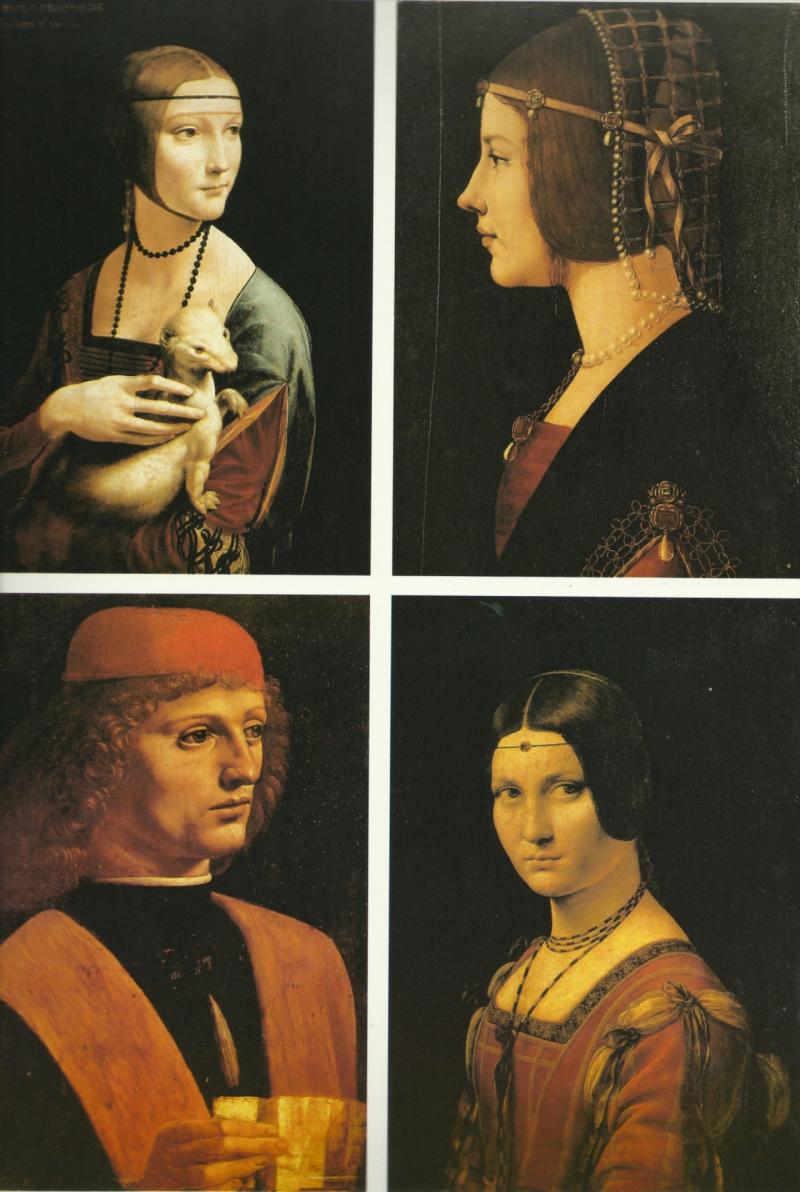
After his brief stay in Venice, where he carried out works as an architect and military engineer, he made a brief stay in Mantua where he made the portrait of " Isabella d'Este " (fig. 15). (Louvre)
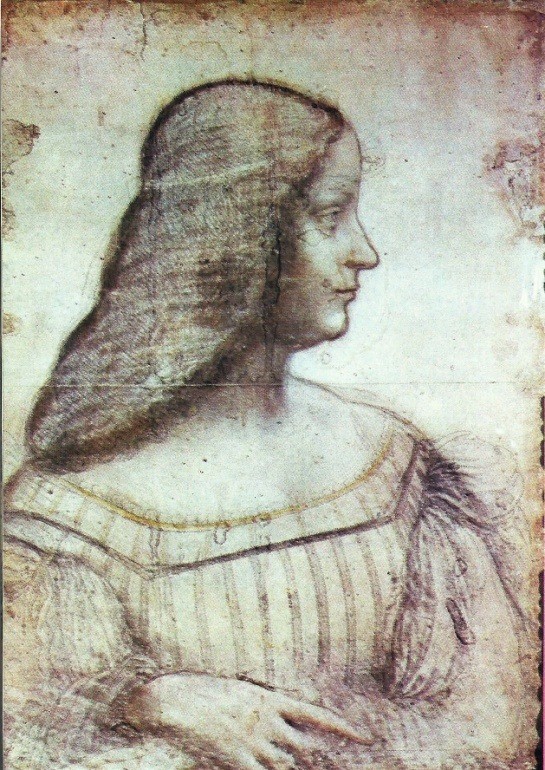
2c. Brief Roman stage (1513-1515)
In Rome he worked for Pope Leon X of the Medici family, standing out mainly for his engineering work to dry out the Pontine Lagoons. His painting was unsuccessful (probably due to the fact that Rome was at that time dominated by the art of Raphael and Michelangelo). He only participated as a painter in the series "Los Diluvios", trying to respond to the work of Michelangelo in the Sistine vault. That stay in Rome was not especially happy, if we pay attention to Leonardo's phrase " The Medicis created me and then destroyed me ".
2d. Leonardo da Vinci in France
In 1515, he was invited to France by King Francis I, a great admirer of the work as Leonardo's painter, who, as has already been said, stayed at the Clos-Lucé castle, near Amboise. During his French stay he participated in the remediation of a marshy region in Romorantin for the construction of a palace for the Queen Mother. From that time is the enigmatic and beautiful painting of " Saint John the Baptist " (fig. 16) (Louvre) whose model was probably Salai. A short time later Salai said goodbye to Leonardo da Vinci and returns to Florence where soon died in a duel.
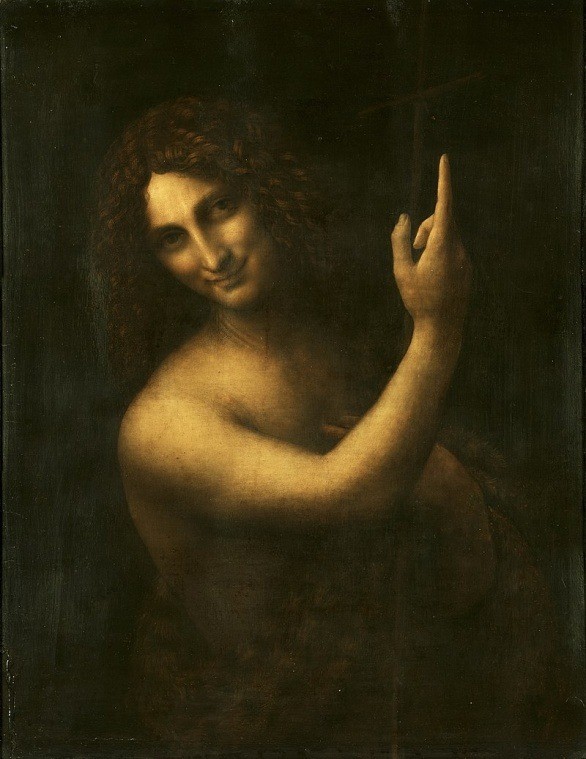
The aforementioned painting, perhaps the most enigmatic of Leonardo with a "sfumato" carried out to its last consequences on a dark background, which heralds the "tenebrism" caravaggiesco, from which emerges that androgynous figure with an enigmatic smile and index finger pointing towards the sky.
Leonardo died in Cloix, near Amboise (said to have been in the arms of Francis I according to Vasari) at the age of 67 on May 2, 1519.
3. Artistic data
If Leonardo is famous for something as an artist and who was a model and inspiration for contemporary and later painters, it is because of the use and development of the "sfumato" pictorial technique of which he was a teacher, as has already been mentioned. The Italian term sfumato is used in Spanish to refer to the characteristic pictorial technique of the Italian Renaissance in which the contours, tones and values of the forms are blurred without leaving traces of the brushstroke, imperceptibly lost in the background. There are no outlines, only color.
In Spanish it is translated as blurred or blurred and is used, in addition to painting, for the drawing technique in which the shading is done with soft transitions of value in which the outline of the contours is imperceptible.
Varied themes appear in his works: religious themes are very important, as has already been mentioned in the detail of his paintings. However, he also excelled and is considered a true master in portraits (the Mona Lisa, the Saint John the Baptist, Isabella d'Este, the Bella Ferronière etc). In all his work with few exceptions, the characteristic landscape backgrounds already in the Renaissance can be seen with great mastery as a reflection of the artist's love for nature in all its forms.
The last painting by Leonardo auctioned at Sothebis on November 15, 2017 was the " Salvator Mundi" (Fig. 17). It was sold in New York for 450 million dollars, about 400 million euros, a record in the art world. This work is dated around the year 1500 (Milanese period).

One cannot forget the great profusion of drawings by the artist with subjects as diverse as portraits, landscapes, human and animal anatomy, engineering projects and gadgets, etc., and which were much more numerous than his pictorial work. Famous are his " Self-portrait " (fig.18), (Royal Library of Turin) made already in his last stages in advanced age
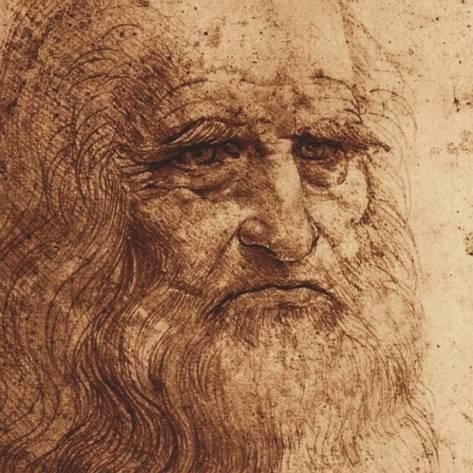
and the " Vitruvian Man " (fig. 19) (Gallery of the Academy of Venice) among many others. The ones included in the image gallery are the above. For reasons of space, no more can be included.
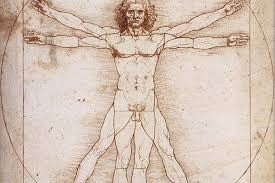
In relation especially to his painting, and as has already been outlined, Leonardo influenced such famous artists as Michelangelo, Raphael, Andrea del Sarto, Pontormo and Correggio, as well as the Venetians Tintoretto and Veronese.
4. Iconological level
Although it has already been exposed in the previous sections, it should be noted that Leonardo da Vinci can be considered as the Renaissance Artist by Antonomasia since he considered, as he stated in some of his treatises, that he did not make distinctions between art and science. His pictorial work and his scientific engravings and drawings are clear examples of this.
His paintings presented important novelties such as the aforementioned "sfumato" technique, his love for nature expressed in the landscape backgrounds of his paintings and even the introduction of tenebrism (San Juan Bautista) that was later used so much by baroque artists (in special Caravaggio).
His evolution, especially in painting throughout his artistic life is clear, observing his painting from his earliest works (contribution to Verrochio's "Baptism of Christ") to the great portrait, such as the Mona Lisa and her Saint John the Baptist who they are groundbreaking with respect to their time still dominated by the powerful influence of the church (religious themes from their early Florentine times).









